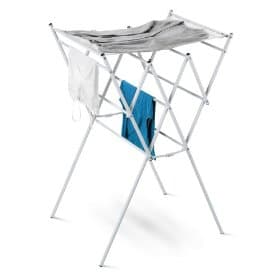- in Green Home , Homekeeping by Alexis Rodrigo
- |
- 2 comments
How to Add Humidity to Your Dry Home without Using Energy
During our first winter in North Ameria, my hubby, children and I were horrified to find our noses bleeding! We soon discovered that it was the very dry and cold indoor air, caused by forced-air heating.
That kind of desert-like air can be hard on our bodies, drying skin and mucus membranes, making us more susceptible to colds and other respiratory ailments – and nose bleeds. Super-dry air can also damage the structure of your home, causing cracks in drywall and gaps in floor joints (dryness causes wood to shrink). And the static electricity is just plain annoying.
Increasing the humidity in your home makes it feel warmer (remember how much hotter the summer weather seemed when it was humid?). A house that feels warmer means you won’t be as inclined to turn up the thermostat, thus saving on energy costs.
So how can you humidify your home without purchasing a humidifier? There are economical ways to increase your home’s humidity. Here are some ideas and tips for moisturizing your house.
1. Re-think how you do the laundry
-Vent your dryer inside
For under $10, you can purchase a simple kit from your local hardware store that will enable you to vent your dryer inside. The moist, hot air from the clothes-drying process will get put back into your home, and the kit catches the lint in a water-filled plastic cup.
-Hang your laundry indoors
Wet clothes dry quickly in the warm, dry air of a heated home. And the moisture that evaporates out of them will be put into the air, humidifying your home. You can use drying racks made for the indoors, or hang clothes from your shower curtain rod. You’ll save electricity by skipping the dryer, too. I use a drying rack like this to dry clothes indoors in late fall and throughout winter:
2. Turn down the heat
While it’s tempting to crank up the thermostat, consider putting on an extra layer or a thick sweater instead. The more you use artificial heat, the drier the air will become.
3. Water
When you are cooking, leave boiling pots uncovered when possible to allow the steam to diffuse throughout the kitchen. Also, leaving an open pot of water in each room will increase humidity simply by evaporation.
4. Open the bathroom door
When you finish your shower (or during your shower if you don’t mind the lack of privacy or the chill), open the bathroom door and don’t run the bathroom fan. After drying off, hang your wet towel up in another room to dry.
5. Vaporizers
Far cheaper and easier to maintain than a humidifier, the same vaporizer you use when you or a family member has a cold can be used to humidify your home. You may already have one on hand.
6. Water those plants
Use a spray bottle to mist your houseplants, and keep them watered (they will need it in the dry air). Be sure you have a dish under each plant, so the water that runs out can be left to evaporate.
These are all relatively small things you can do, but they can have a big impact on your health and your finances.
If you liked this post, submit your email address below to get new posts by email:

